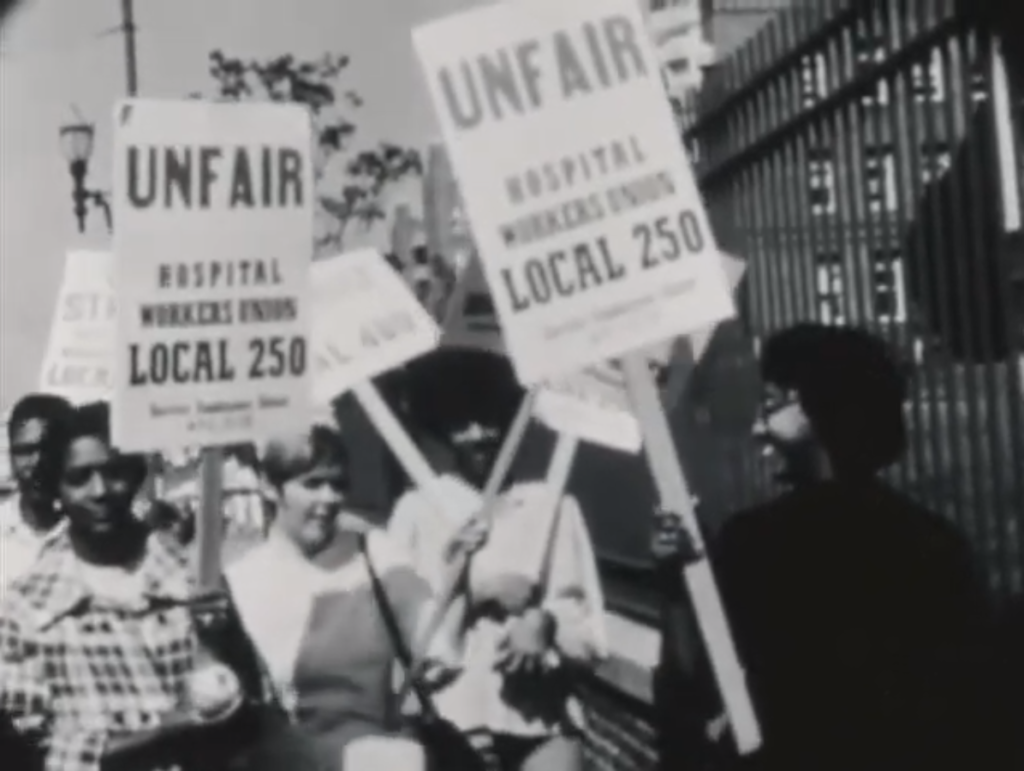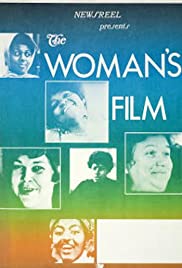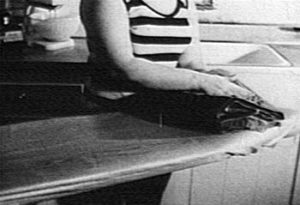
I can’t remember precisely the first time I saw The Woman’s Film, a collaborative short documentary made by San Francisco Newsreel in 1971, but I do remember being struck by its boldly feminist mode of address and content. It has stuck with me for years and now I use it in class anytime I can. I have shared it with colleagues in sociology, art history, and gender studies, as well as anyone else who is interested in the history of the women’s movement in America. The film is celebrating its fiftieth anniversary in 2021 and was honored with a special screening at the 2020 Berlinale. I urge everyone to watch it; the issues it raises are still relevant half a century later.

The film was made by a team of women from San Francisco Newsreel, one of a number of such organizations working throughout the United States in the 1960s and 70s. Newsreel groups were collectives of activists associated with the left who used media to document and foster social change. The team of women who made The Woman’s Film were not filmmakers; they learned media production skills on the job. In a recent panel discussion (via Zoom), Louise Alaimo and Judith Smith, two members of the production team, shared reflections on the origin of the film and their experiences making it. The discussion emphasized that individuals who are dedicated to living their principles can work together to promote social justice. Their media activism serves as a model for those who are engaged in the fight to make positive change.
The idea for The Woman’s Film came about in the late 1960s, when the group perceived a need for a film about the women’s movement – one that would reflect a broader view than the white, middle-class segment (as exemplified by Betty Friedan’s 1963 classic, The Feminine Mystique). They wanted to delve into the role of working people in the struggle for social justice. They wanted to create a film that would offer a different perspective on the revolutionary mood of the time.
A steering committee at San Francisco Newsreel made decisions about who would take on what role in the production process. Three people were assigned to make the film and others were assigned to work in the office. Members of the organization pooled their wages to support each other; most of them had working-class jobs and meager salaries. Alaimo was asked to work sound and she learned how to operate the NAGRA recorder. Smith worked the camera and Ellen Sorrin rounded out the team. None of the women is credited individually on the film; the collective spirit of the film is honored. This decision links the film to the collaborative actions that it documents and challenges the auteurist culture of the Hollywood industry.

Alaimo and Smith described San Francisco Newsreel’s commitment to social change as infusing everything they did. Their work was driven by passion and principle. They had reading groups and discussion groups; they were a radical leftist organization that believed in revolution and they were trying to help make it happen. Because of their commitment to leftist politics and grassroots activism, they reached out to organizations such as the Black Panthers, Welfare Rights, the United Farm Workers, the Radical Union, and the Oil and Chemical Workers. From these connections came their main subjects and also footage of various meetings.
The team first captured their footage at a rally for International Women’s Day in San Francisco in 1970. Rallies, marches, and strikes are prominent throughout the film. These direct actions serve as a kind of primer for viewers, who might want to get involved in activism but are not sure how. Contemporary viewers will see a range of options for becoming socially active, both on the front lines and behind the scenes. The film is organized around consciousness-raising in a set of concentric circles, beginning with personal awareness, then moving out to recognition of how you can help others in your local sphere, to activism in the workplace, and then to a national level.
Consciousness-raising groups, often referred to as CR groups, were a hallmark of second-wave feminism, encouraging women to speak to each other and share their experiences to understand that their concerns were not theirs alone. The film highlights the power of these groups to foster understanding, brainstorm strategies, and plan solutions. Critics of the women’s movement have accused these groups of being navel-gazing, self-indulgent therapy sessions. However, the film shows that women were using the knowledge they gained – both about issues and about their own abilities – to go out into the world and make change. As Carol Hanisch describes in her 1970 essay, “The Personal is Political,” these sessions were analytical and a form of political action. This phrase became a rallying cry of the Women’s Liberation Movement in the 1970s. However, Hanisch credits the editors of the pamphlet in which it appeared (Shulamith Firestone and Anne Koedt, members of New York Radical Women) with crafting the title.
Although critics of the second wave highlight its racial and class biases, The Woman’s Film offers evidence of diversity in social justice movements at the time. The footage returns to three subjects, Florence, Mary, and Vonda, who are racially diverse working-class women. These women were chosen because they had found ways to channel their anger into action and become part of the solution. As Smith and Alaimo describe, they wanted to be able to show a transition from frustration to working for social change in a short amount of time. All three became activists and we see footage of them near the end of the film speaking at a rally. However, I would not describe these three as “protagonists;” the film, like its production team, is non-hierarchical and egalitarian in its representation of the movement. The film’s focus is largely on groups, rather than individuals. Only Vonda and Mary are shown in individual interviews. Florence speaks to the camera during a traditional CR group, with other women and children in attendance.
One of the themes of the film is women’s work and the responsibilities that women undertake to make households run. Children are present in many of the scenes; they have been brought to the gatherings or are being watched at play, presumably while other women are at work. My favorite scenes are the shots of women doing housework: they dust, wash dishes, cook, and iron. While such action may sound mundane, these are revolutionary sequences, partly because showing women doing the work they do every day brings it to light and emphasizes its drudgery. It is normalized and made strange at the same time. In one scene, Florence’s teenage daughter comes home with groceries and she and her siblings unload them. Florence questions her daughter about what she got and how much it cost; the daughter has to explain that she didn’t buy bananas because they did not fit in the budget, as her mother taught her. These are women working in their homes, performing necessary labor, for neither pay nor credit. By focusing on this work and the women who do it, the filmmakers foreground the labor required to make society run. In this respect, the film is a Marxist undertaking, as most often this kind of labor is hidden.
The labor that women do out in the world is also highlighted – jobs like laundry, serving in restaurants, working phones, nursing, typing, and sewing. Close-ups of hands doing this work and repeated actions call attention to its monotony. In one CR group, women talk about gender discrimination at the phone company, the largest employer of women at the time, and the publishing industry. A woman who worked as a secretary and editorial assistant interrogates her privilege when she reflects on her identity as a middle-class white woman with a good job. Describing the exploitation she endured at the hands of her male boss, she asks, “What is oppression? Who is oppressed?” The film also captures footage of migrant workers and their living quarters. From these sequences, the film transitions to meetings of various political and social organizations, including a Chicano labor organization and a welfare rights group, both of which are racially diverse. Here the filmmakers demonstrate how women take their new awareness and channel it into actions for social change. As one Latina woman describes, belonging to the movement gives her something to live for, and breaks up her day, which is otherwise filled with cooking, cleaning, and doing things for her family.

Finally, the film documents protests, strikes, and marches by different organizations, which represent another level of involvement for women. Vonda’s trajectory symbolizes this development, as we see her reflect on being treated poorly by her first husband, then find her voice in supporting her second husband on the picket lines and then starting a labor newspaper. One of her scenes is a favorite of mine: she tells us about how her first husband would tie a string across the door when he left to go to work at night, to make sure she didn’t leave the house. She stands at an ironing board as she tells the story, describing in a matter-of-fact tone how she wasn’t pleased by this action, and so she divorced him. The next shot cuts to her picking up her bowling ball bag, walking out the door, and shutting it behind her.
In addition to the footage of CR groups and direct actions, non-diegetic inserts function as transitions between the various sections. These montage sequences provide history, background, and context for the more personal reflections shared by the women. The film opens with a series of photos showing women with children, women at work, women cooking, women cleaning, lipstick, and accouterments of the wedding industrial complex, set to a version of “(I Can’t Get No) Satisfaction” sung by Aretha Franklin. Through her voice, the song becomes an unapologetic critique of society’s exploitation of women. Perhaps the most powerful sequence is a montage about slavery with archival photos, handbills, and drawings. These vivid and horrifying images are backed by a slave auctioneer’s rhyme, highlighting the sale of African women. It is a bit jarring placed here: it follows a segment in which a Black activist speaks about inequality in the education system and precedes the section on welfare. The filmmakers highlight strong Black female voices in both sequences; the women speak out about the urgency of change and the inevitability of revolution. Paired with the historical montage, the film draws a line from the past to the present, perhaps suggesting that the welfare system is a modern form of slavery. The film does not disguise its subjects’ critique of this problematic economic institution; it amplifies their description of America’s economic divide. The choice to include this economic critique is a radical one that echoes the revolutionary ethos of San Francisco Newsreel.
A filmmaking team of all women was radical at the time – it would even be radical today. In a quick cut, the film turns the camera on the production team, so we can see the women behind the camera, and one of the participants in a CR group says how surprised and delighted she was to see the all-female crew. As we’ve heard over the past few years, women behind the camera are few and far between. Although this is changing (see this year’s Golden Globe nominees), the mainstream media industry still has a long way to go to foster equity.
Also distinctive was the film’s synchronous sound. Previous Newsreel films were shot without synch sound and featured voiceover, which was not only easier, but also cheaper to make. In the panel discussion, Alaimo and Smith reflected on their desire to challenge traditional documentary conventions like the use of talking heads. They wanted the film to be more personal and have their subjects communicate information directly. This was a radical approach, as the women in the film become the “experts,” talking about their own lives and experiences.
The creators of The Woman’s Film were inspired to capture a moment on film. And we should be thankful that they did – 50 years later it still sends a powerful message. Over 90 people from all over the world attended the Zoom panel discussion. The Woman’s Film highlights material issues that persist today, for young women and others – the economic divide, unfair labor practices, racial injustice, and limiting gender norms. Perhaps we can all use the film as a lesson in how to educate ourselves, organize and make positive change.
JENNIFER L. GAUTHIER is a professor of media and culture at Randolph College in Southwestern Virginia. Her media commentary can be found on Pop Matters.com and The Critical Flame: A Journal of Literature and Culture. She has poems published or forthcoming in Tiny Seed Literary Journal, South 85, Gyroscope Review, Nightingale & Swallow, River River, The Bookends Review, little somethings press, and HerWords Magazine. Her poetry collection, naked: a chapbook of poetry inspired by remarkable women, was recently chosen as third runner-up in the New Women’s Voices poetry competition sponsored by Finishing Line Press.
